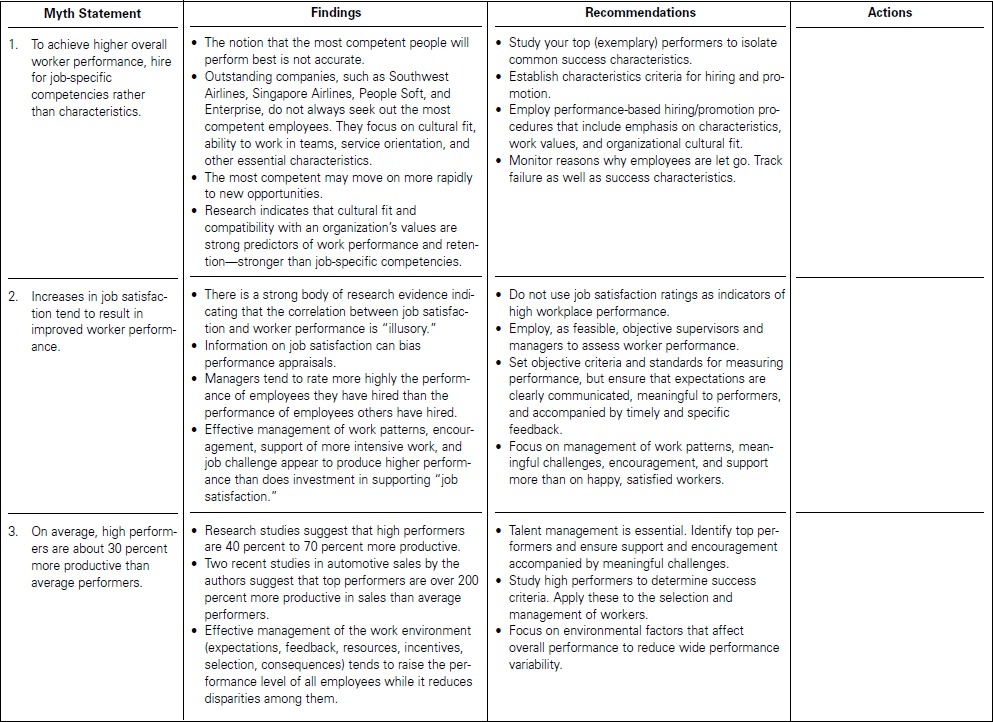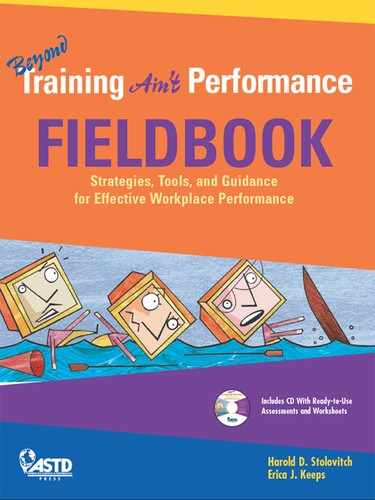Chapter 13
Hit or Myth: Facing the Facts
This chapter
![]() reviews the 12 myths about performance improvement presented—and demythologized—in Training Ain't Performance
reviews the 12 myths about performance improvement presented—and demythologized—in Training Ain't Performance
![]() adds recommendations for counteracting the perpetuation of myths
adds recommendations for counteracting the perpetuation of myths
![]() helps you and your WLP team to commit to productive actions that fit with your organizational environment.
helps you and your WLP team to commit to productive actions that fit with your organizational environment.
Tools in this chapter include
![]() a hit-or-myth worksheet that includes the 12 myths from Training Ain't Performance, presents key findings to counter them, offers recommendations for practice, and leaves space for you and your team to enter productive actions that fit your organizational culture and setting.
a hit-or-myth worksheet that includes the 12 myths from Training Ain't Performance, presents key findings to counter them, offers recommendations for practice, and leaves space for you and your team to enter productive actions that fit your organizational culture and setting.
The Amazing Power of Myth
You drop a mirror that smashes into hundreds of fragments. Quick, what's your first thought? Is it “Oh no! What a mess” or “Oh no! Seven years of bad luck”? When we pose this question to our conference and workshop participants, about 70 percent admit that they first think of seven years of bad luck.
Superstition is powerful. It's perpetuated by peoples' belief in superstitions or, because they've heard the superstition expressed so often, by a feeling that it can't hurt to be cautious. We knock on wood to keep away “bad luck” or carry an amulet to invite good fortune. Almost all of us say “Bless you” when someone sneezes. (Just try a quiet sneeze in an elevator and listen to how many strangers utter this very thoughtful expression.) Its purpose includes everything from preventing the devil from entering your throat to keeping your heart beating.

We still find a large number of myths and superstitions circulating in our organizations today. In chapter 11 of Training Ain't Performance, we delivered a dozen of them to you. We also presented arguments against each of the myth statements. In this chapter of the Beyond Training Ain't Performance Fieldbook, we take you one step farther to the application level. We'll revisit each myth and the key findings about it, and then we'll present recommendations for practice. Your job, and that of your team, will be to bring these recommendations to life.

An Activity for You
Study the statements in Worksheet 13-1. Examine the findings and recommendations associated with each myth. Think about your work, your clients' performers, past successes and failures, the culture of your organization, and your own capabilities. For each myth statement, enter at least one action you can take to better align your performance improvement practices with what is recommended. You're not limited to one action. Feel free to enter as many as you believe feasible. If you're already doing some things that align with the recommendations, enter these and pat yourself on the back. We salute you in advance.
Separating yourself and your organization from beliefs and practices that are part of the culture isn't easy, but it's surely worthwhile to put aside what isn't going to help achieve results that everyone values. When you complete the worksheet, pause, reflect on how far you've come, and congratulate yourself for assuming this professional leadership role.


An Activity for Your WLP Team
When you have completed your own set of actions (either actual or projected) in Worksheet 13-1 and reflected on how you can counteract the myths while advancing your professional cause, meet with your team. Have them do the Hit or Myth exercise on page 176 of Training Ain't Performance. Debrief their choices using the text in chapter 11(pp. 175-184). Then share Worksheet 13-1 from this Fieldbook. Show your action entries, and ask the team to build on these. Record their suggested (or actual) actions. When completed, circulate a list of these actions to your entire team to stimulate professional practice based on research.
As a further activity, you and your team can become myth-buster sleuths. Identify practices in your organization that you feel are not productive. Performance appraisal is a great place to start. Go to the Internet to find research and best practices data to debunk the myths underlying unproductive, even counterproductive, practices.
Worksheet 13-1: Myths Versus Facts, and the Actions You Will Take to Counter Myths





Chapter Summary
This chapter
![]() reviewed a dozen myths from Training Ain't Performance.
reviewed a dozen myths from Training Ain't Performance.
![]() provided recommendations for countering all of those myths.
provided recommendations for countering all of those myths.
![]() encouraged you to list actions that are feasible within your organization and that take you away from myth-based performance improvement practices.
encouraged you to list actions that are feasible within your organization and that take you away from myth-based performance improvement practices.
![]() had you play the Hit or Myth game from Training Ain't Performance with your WLP team, debrief it, expand feasible actions for going beyond the myths, and encouraged you and your team members to become myth detectives.
had you play the Hit or Myth game from Training Ain't Performance with your WLP team, debrief it, expand feasible actions for going beyond the myths, and encouraged you and your team members to become myth detectives.
We are asking a lot of you because we believe that the effort you invest will provide huge returns to you personally and to your organization. This requires not only investment in making the effort, but also in increasing your own professional performance capabilities. That's the subject of the next chapter that focuses on strengthening you professionally.
